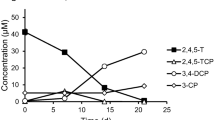Abstract
Material balance studies of glutaraldehyde in a river water–sediment system demonstrate that glutaraldehyde preferred to remain in the water phase. Glutaraldehyde was metabolized rapidly under both aerobic and anaerobic conditions. The pseudo-first-order half-life of catabolism, based on the loss of glutaraldehyde from the water phase, was 10.6 h aerobically and 7.7 h anaerobically. In contrast, under sterile conditions at pH 5 or 7, no appreciable degradation of glutaraldehyde was observed over a 31-day period. At pH 9, about 30% of the glutaraldehyde degraded over the same period. The major degradate was identified as 3-formyl-6-hydroxy-2-cyclohexene-1-propanal, a cyclicized dimer of glutaraldehyde. The extrapolated half-life of abiotic degradation was 508 days at pH 5, 102 days at pH 7, and 46 days at pH 9. Under aerobic conditions, glutaraldehyde was first biotransformed into the intermediate glutaric acid, which then underwent further metabolism ultimately to carbon dioxide. Metabolism of glutaraldehyde under anaerobic conditions did not proceed ultimately to methane, but terminated with the formation of 1,5-pentanediol via 5-hydroxypentanal as an intermediate.
Similar content being viewed by others
Author information
Authors and Affiliations
Additional information
Received: 20 August 2000/Accepted: 3 April 2001
Rights and permissions
About this article
Cite this article
Leung, HW. Aerobic and Anaerobic Metabolism of Glutaraldehyde in a River Water–Sediment System. Arch. Environ. Contam. Toxicol. 41, 267–273 (2001). https://doi.org/10.1007/s002440010248
Issue Date:
DOI: https://doi.org/10.1007/s002440010248




